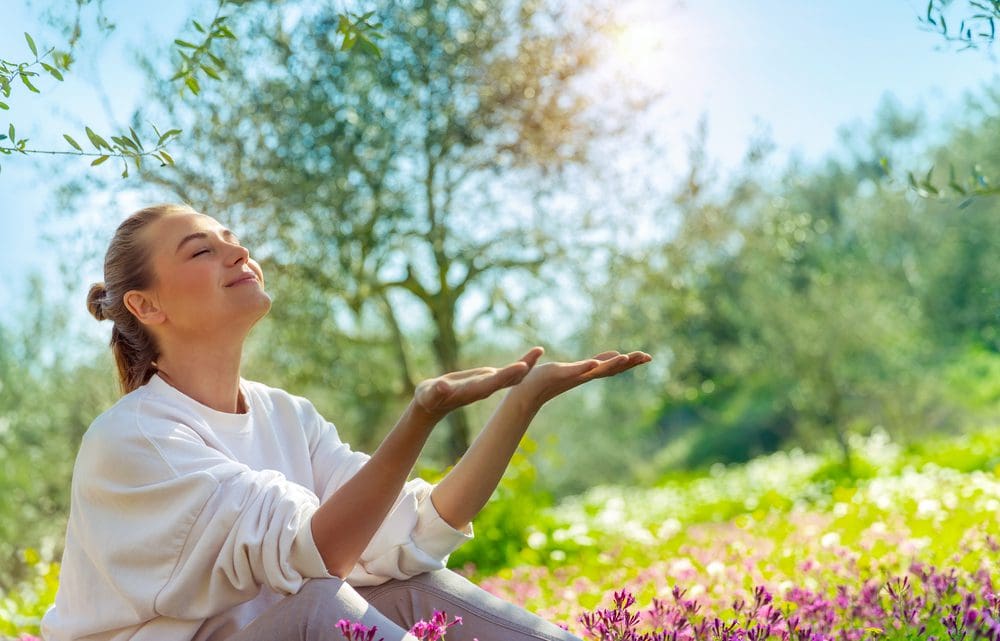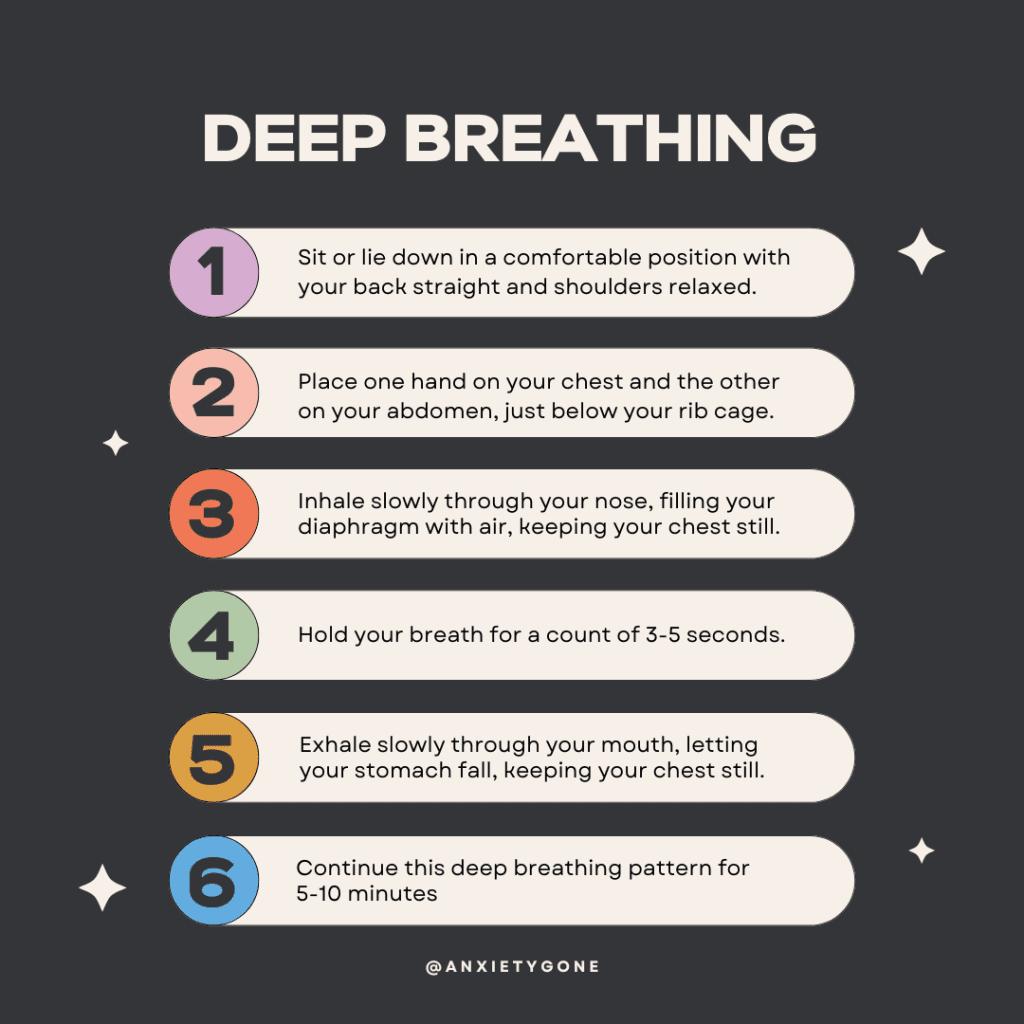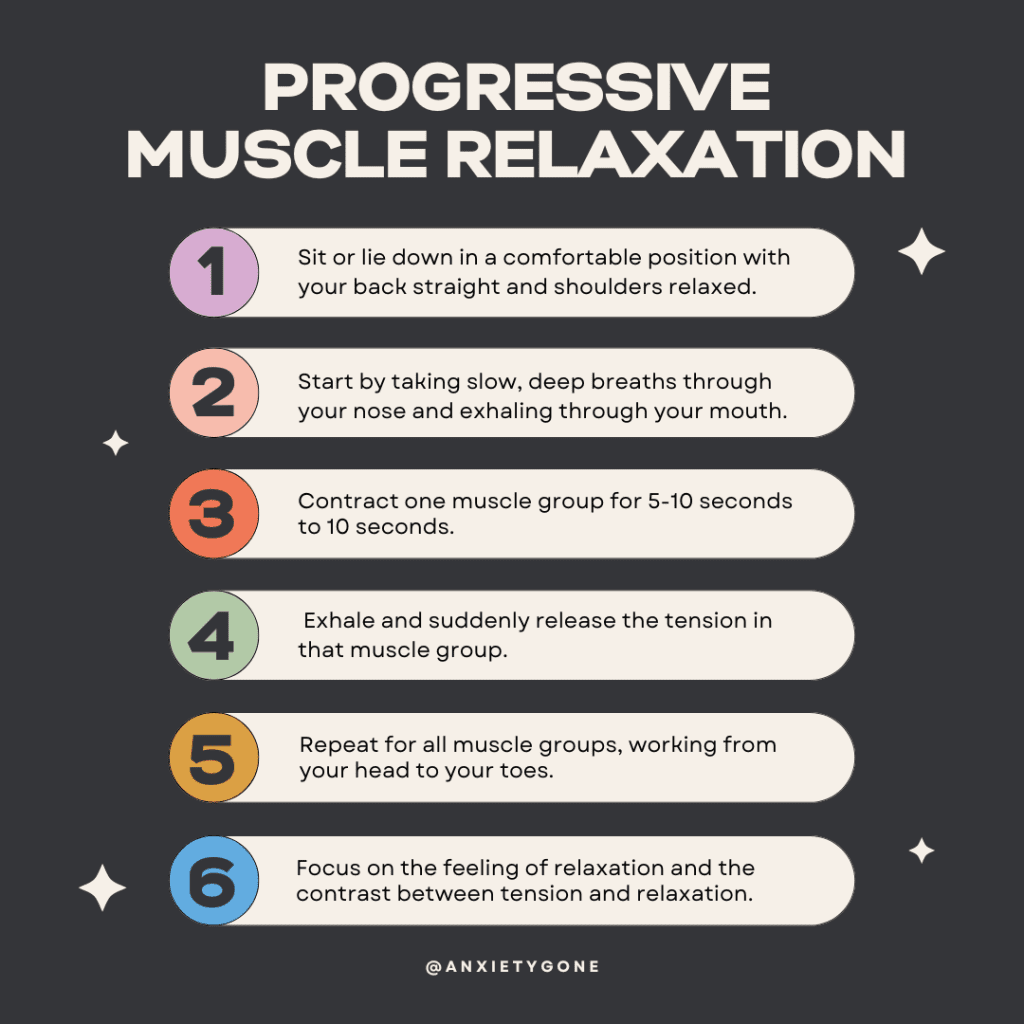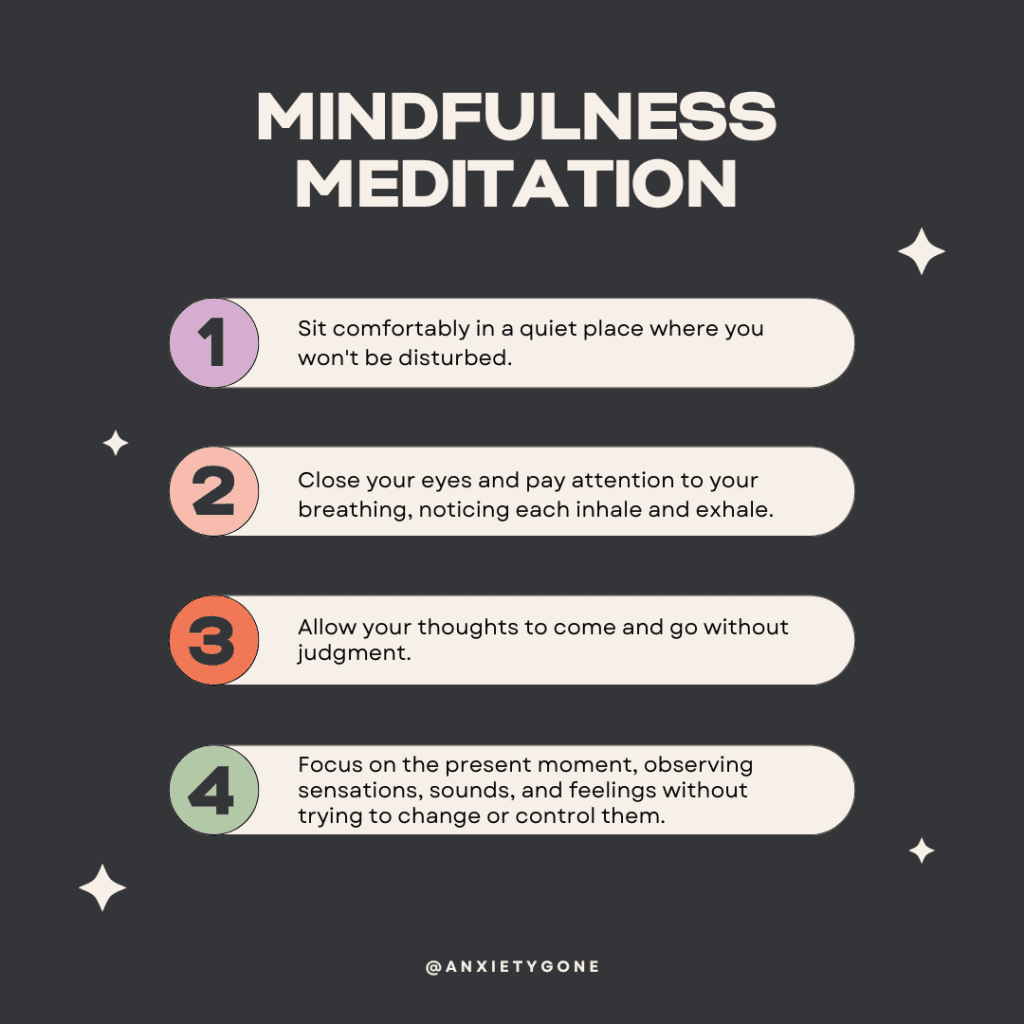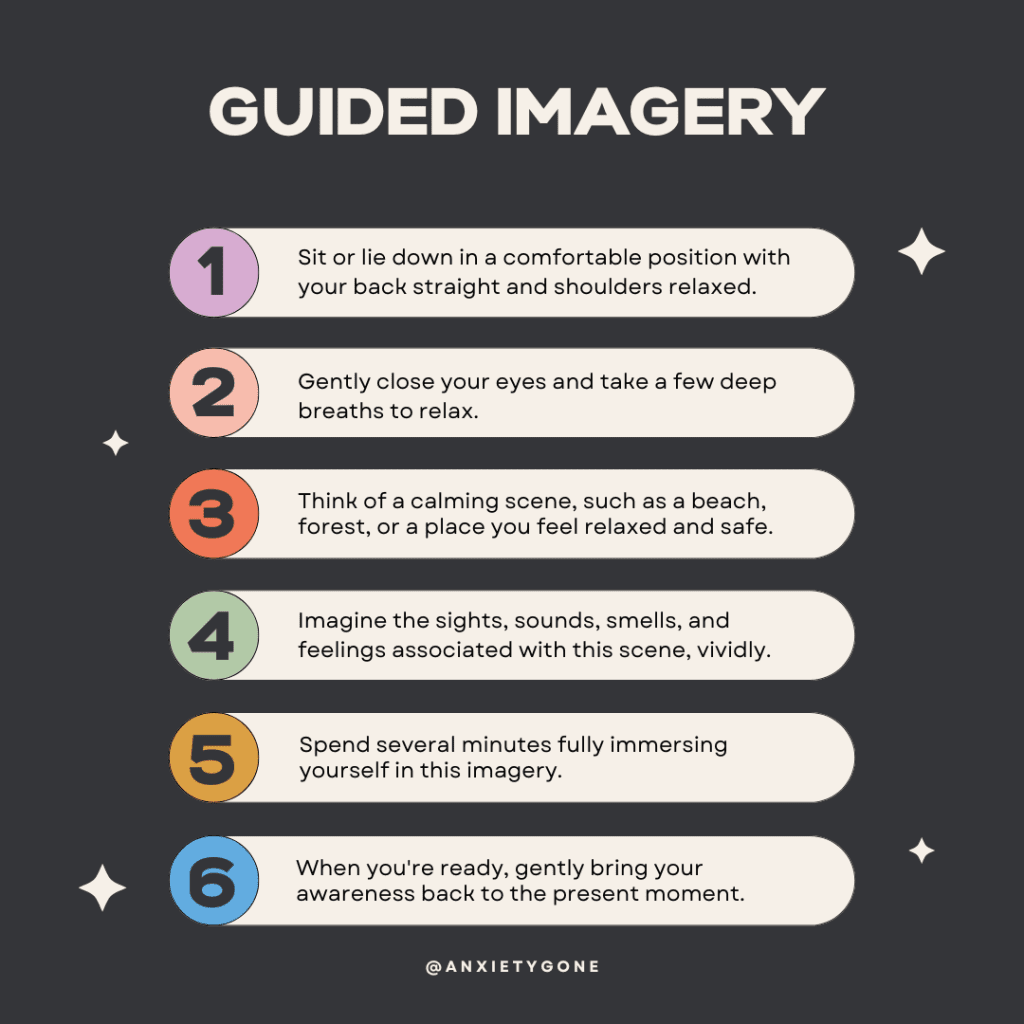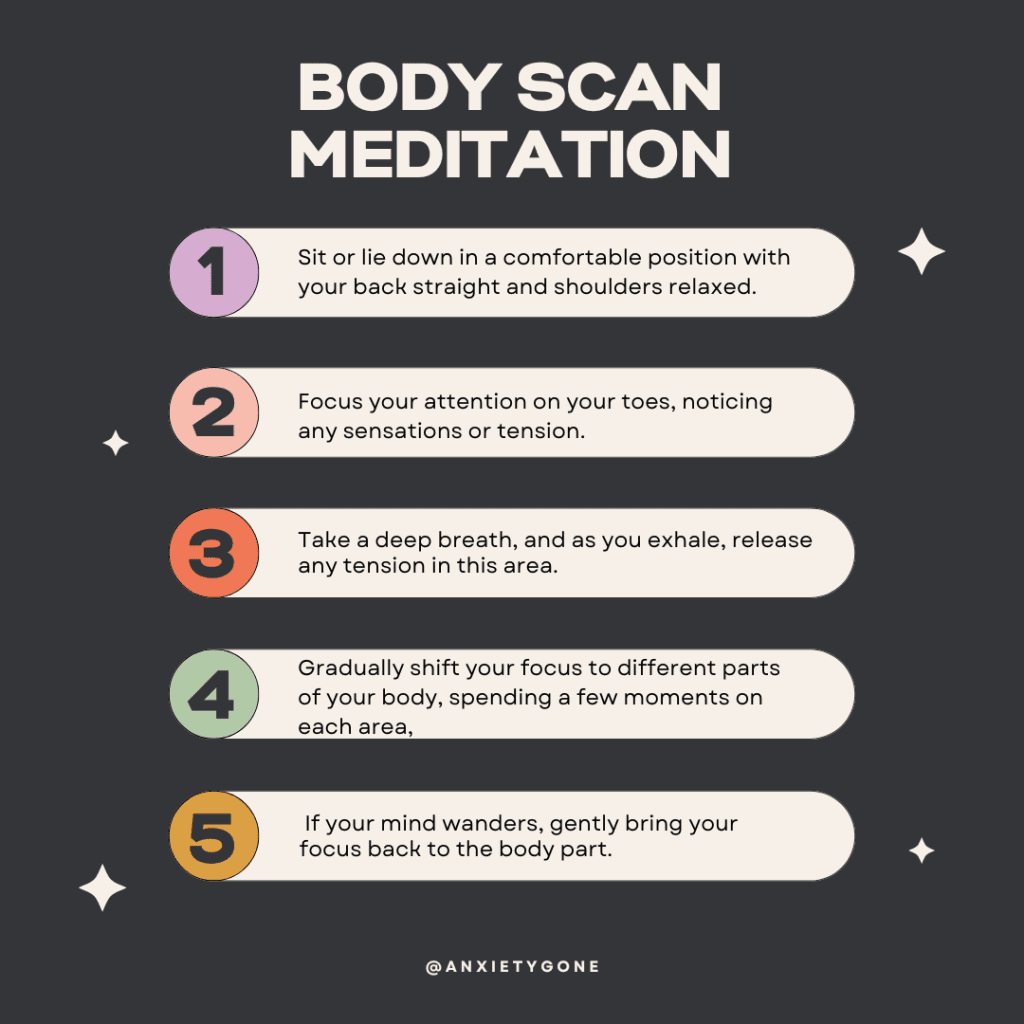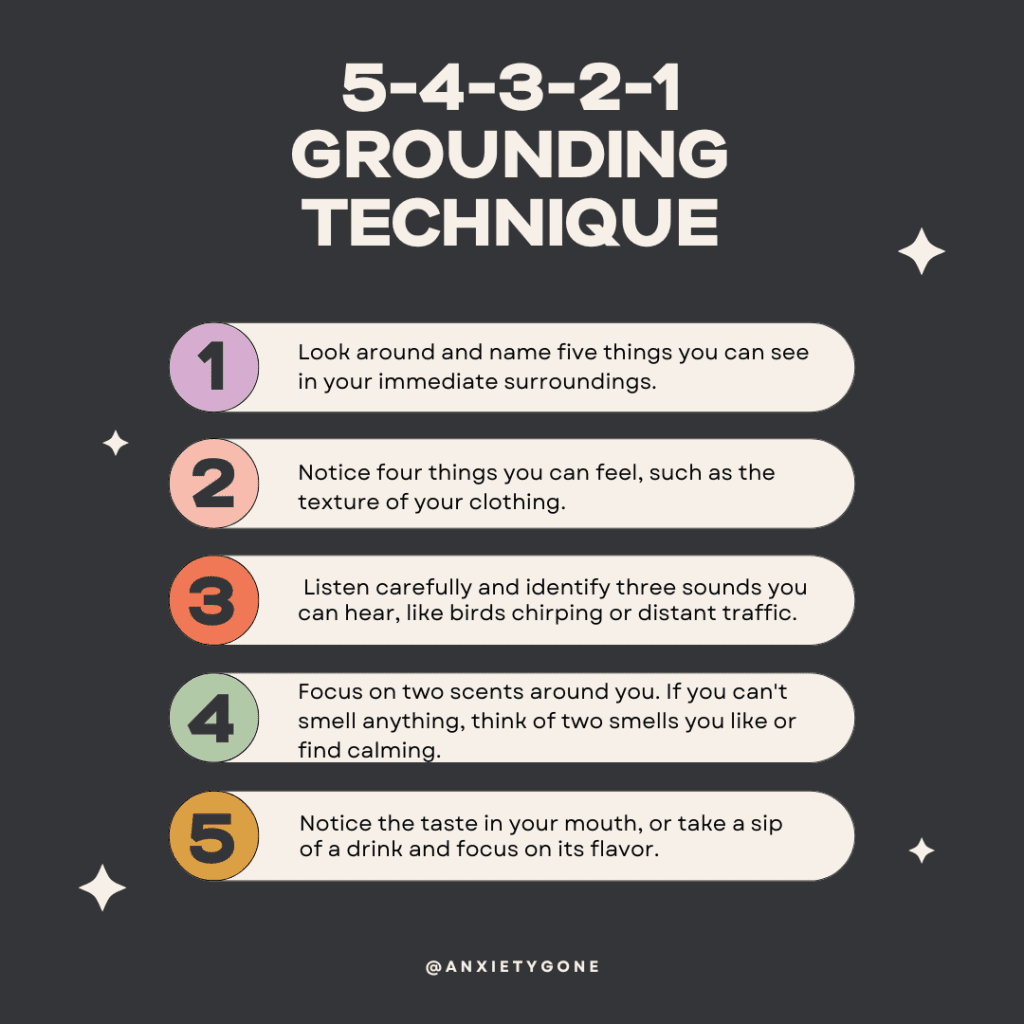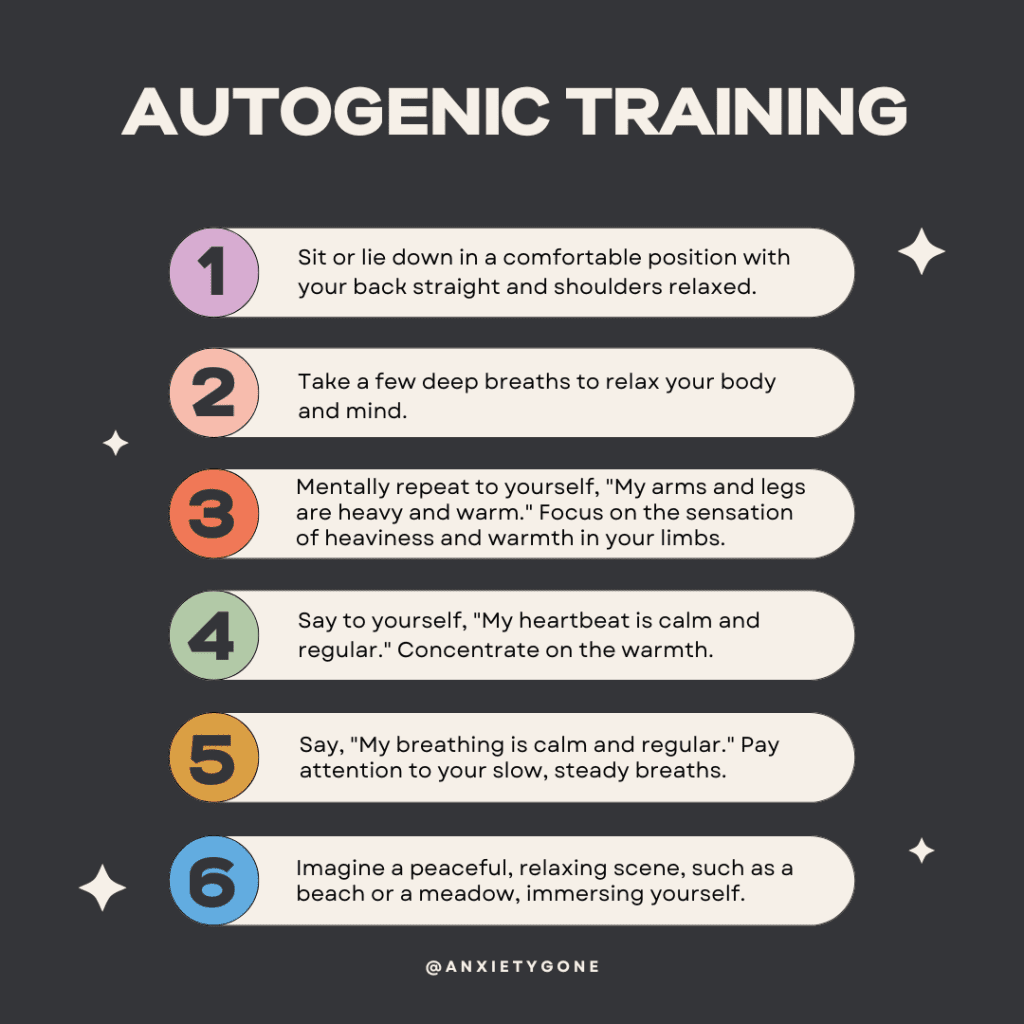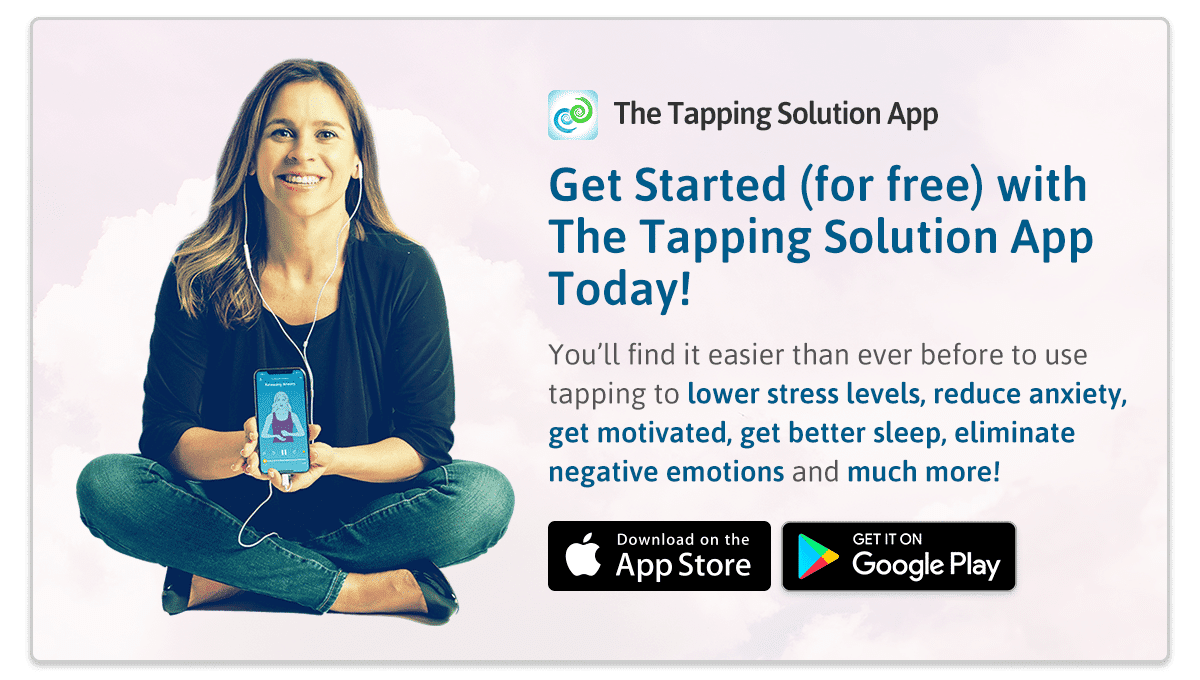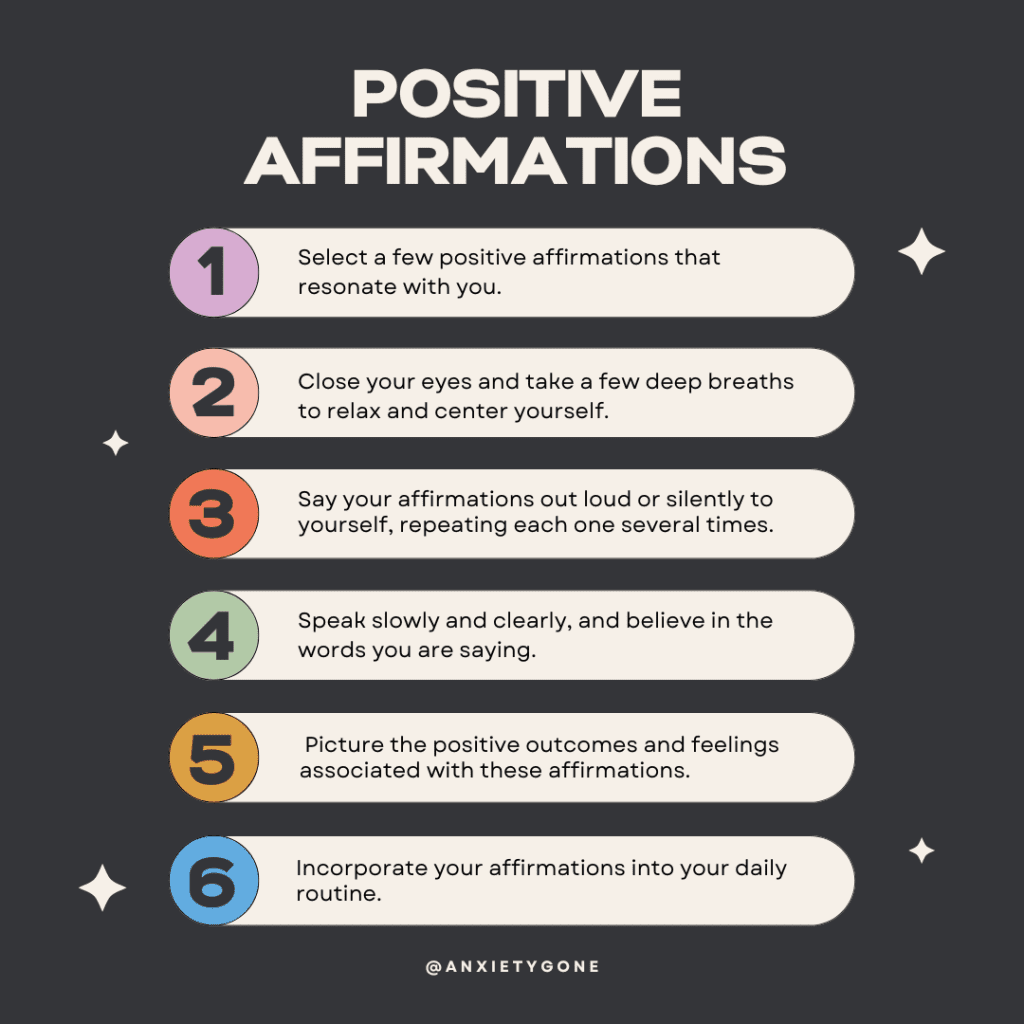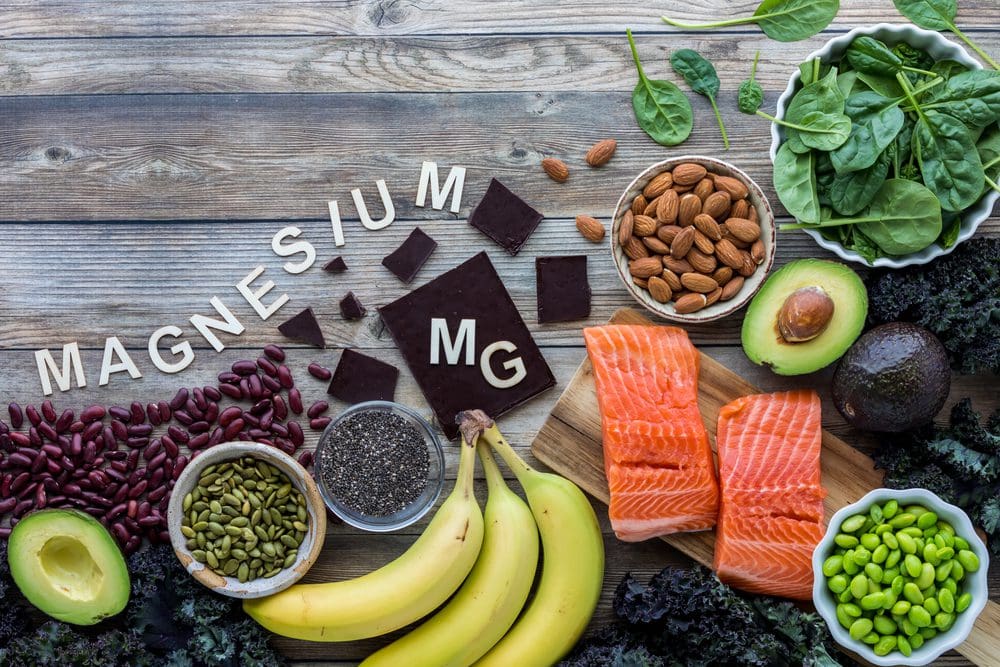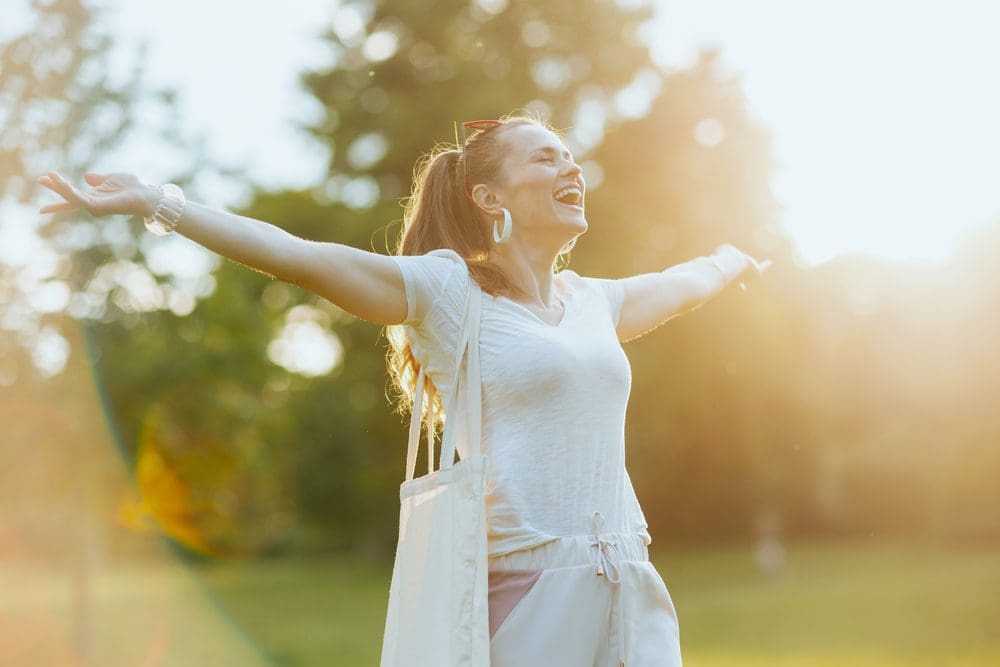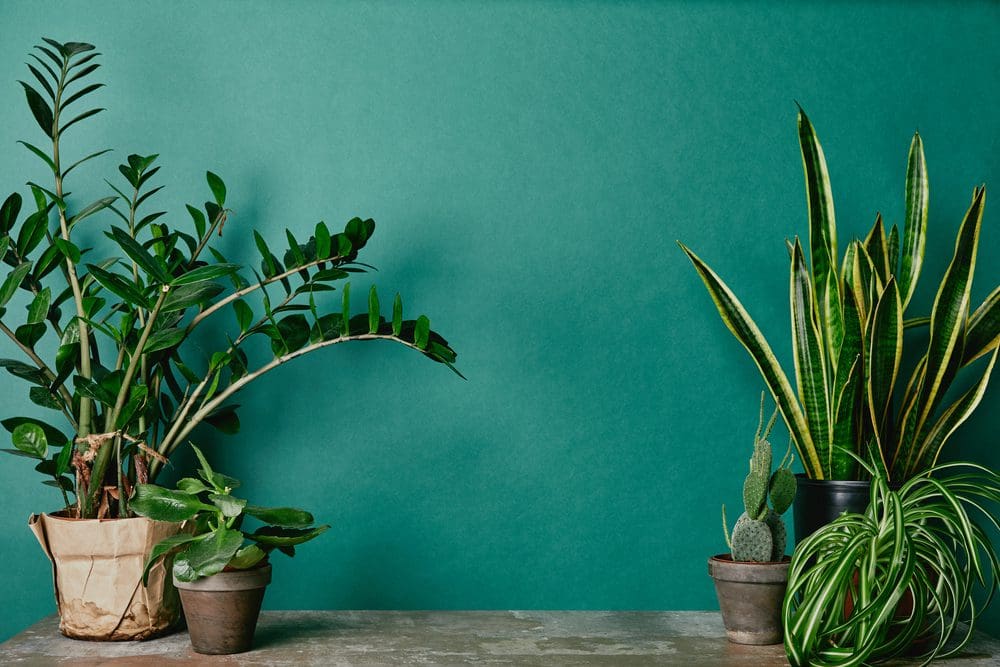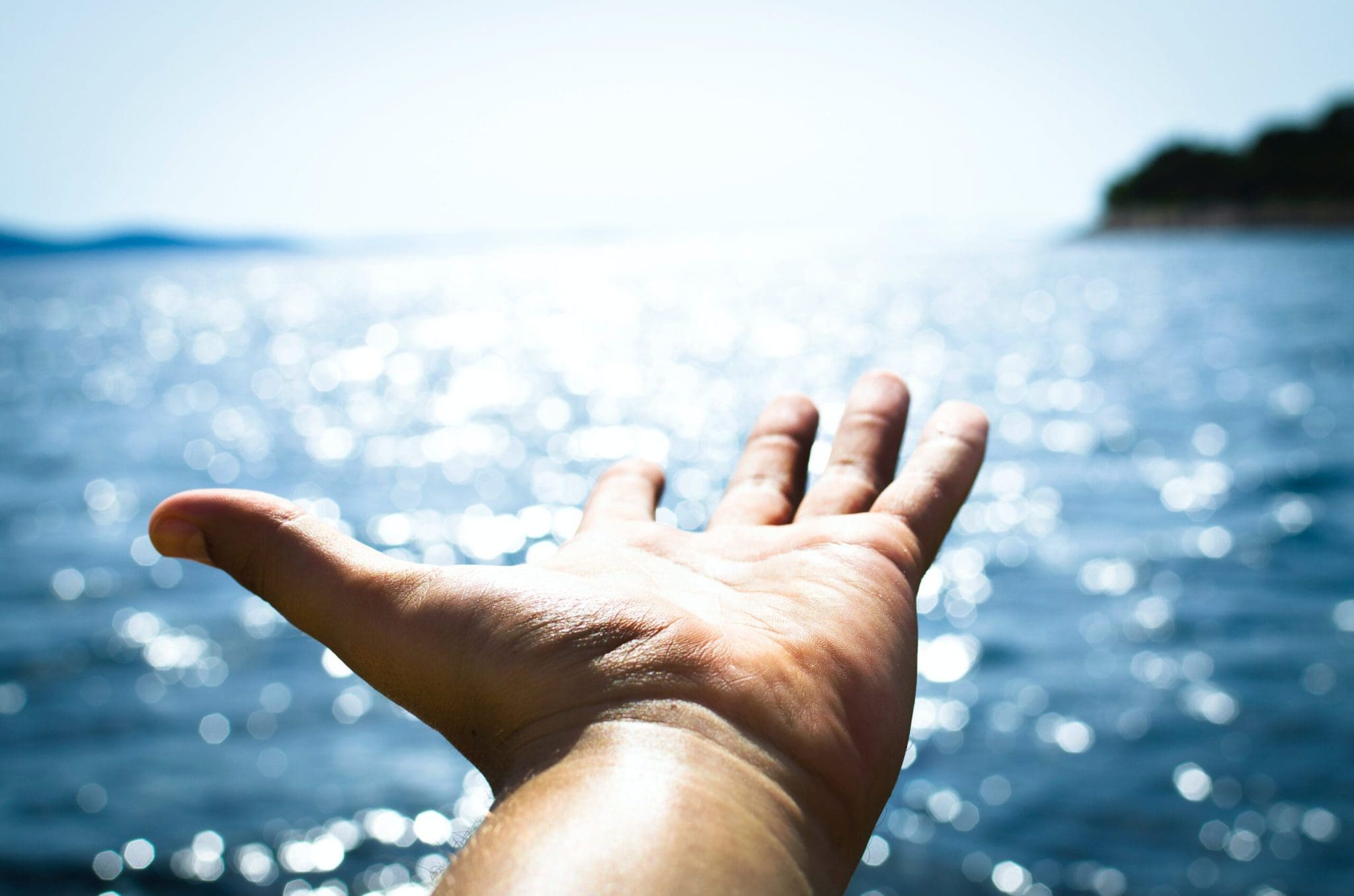Full Disclosure: Clicking on these links could mean a tiny commission for me, at no extra cost to you.
To effectively combat anxiety, it’s essential to trigger your body’s natural relaxation response. This can be done using relaxation techniques, like deep breathing, visualization, meditation, and yoga. Relaxation techniques are excellent tools for stress management and anxiety relief, as they effective reduce the effects of stress on your mind and body. Using relaxation exercises can also help you cope with everyday stress and manage long-term stress or stress related to various health issues, such as heart disease and chronic pain. Whether your stress levels are high or you’re on the verge of an anxiety attack, there are many relaxation techniques for anxiety that will help you find your inner calm quickly and effectively.
What are Relaxation Techniques?
Relaxation techniques are strategies used to reduce stress and induce a state of calm in both the mind and body. These techniques help to activate the body’s natural relaxation response, which counteracts the effects of stress.
Common relaxation techniques include deep breathing exercises, visualization, meditation, yoga, progressive muscle relaxation, and mindfulness practices.
The Science Supporting Relaxation Techniques for Anxiety Relief
Here are some other key evidence-based benefits:
- Activates the parasympathetic nervous system, which promotes a state of calm and rest
- Helps counterbalance the “fight or flight” response initiated by the sympathetic nervous system.
- Reduce the production of stress hormones such as cortisol and adrenaline, resulting in decreased anxiety and improved mood.
- Stimulate the release of endorphins, the body’s natural “feel-good” chemicals.
- Practices like yoga and deep breathing improve heart rate variability, a factor associated with better emotional regulation and reduced anxiety
- Meditation and mindfulness increase activity in the prefrontal cortex, the brain region responsible for executive functions like decision-making and emotional control.
- Promote neuroplasticity, enhancing the brain’s ability to adapt and cope with stress.
- Helps reduce physical tension, a common symptom of anxiety.
- Relaxed muscles signal to the brain that the body is in a safe and calm state, reducing overall anxiety levels.
- Help regulate breathing patterns, reducing hyperventilation.
- Slow, deep breaths increase oxygen intake and promote relaxation.
- Strengthen the mind-body connection, helping you become more aware of your physical and emotional states for better stress management and emotional regulation.
- Increases levels of neurotransmitters such as serotonin and gamma-aminobutyric acid (GABA), which have calming effects on the brain.
Most Effective Relaxation Techniques for Anxiety
Finding effective ways to manage anxiety is crucial for maintaining mental and physical health. Among the various coping strategies available, some relaxation techniques stand out for their ability to quickly and effectively reduce anxiety symptoms. These techniques, which include deep breathing exercises, mindfulness meditation, yoga, and progressive muscle relaxation, are backed by scientific research and have been shown to help people achieve a state of calm and improve their overall mental health and well-being.
1. Deep Breathing Exercises
Don’t be mistaken by its simplicity; this relaxation technique will save the day whenever you’re having an anxiety attack. Learning how to deep breathe properly is one of the best things you can learn as someone with an anxiety disorder. Regular breathing isn’t going to cut it either.
Deep breathing exercises use specific breathing techniques to help you calm down and ease anxiety. They can slow down your heart rate, help you catch your breath, and help you come out of the flight or fight state. There are all kinds of effective breathing techniques for anxiety, so it’s important to try different ones to find the best ones for you specifically.
To start using this relaxation technique for anxiety, here are some easy steps:
- Find a Comfortable Position: Sit or lie down in a comfortable position with your back straight and shoulders relaxed.
- Place Your Hands: Place one hand on your chest and the other on your abdomen, just below your rib cage.
- Inhale Deeply: Breathe in slowly through your nose. Focus on expanding your diaphragm so your stomach moves outward, while the hand on your chest remains relatively still.
- Hold Your Breath: Hold your breath for a count of 3-5 seconds.
- Exhale Slowly: Exhale slowly through your mouth, allowing your stomach to fall inward as you release the air. The hand on your chest should still remain relatively still.
- Repeat the Process: Continue this deep breathing pattern for 5-10 minutes, focusing on your diaphragm’s movement and maintaining a steady, slow rhythm.
You can also sign up for online breathwork classes, which teach you powerful breathwork techniques for your health and wellness.
Inward Breathwork is offering our audience (that’s you!) a full month free when they sign up here.
2. Progressive Muscle Relaxation
Progressive muscle relaxation involves tensing and then relaxing different muscle groups, helping to reduce physical tension and anxiety. This relaxation technique can lower stress levels, improve sleep, and increase overall relaxation.
Here are the steps for progressive muscle relaxation:
- Find a Comfortable Position: Sit or lie down in a comfortable position in a quiet environment.
- Close Your Eyes: Gently close your eyes and take a few deep breaths to center yourself.
- Focus on Your Breathing: Start by taking slow, deep breaths, inhaling through your nose and exhaling through your mouth.
- Tense and Relax Muscle Groups:
- Feet: Curl your toes tightly, hold for 5-10 seconds, then release and relax for 10-20 seconds.
- Legs: Tense your calf muscles by pointing your toes, hold, then release.
- Thighs: Tighten your thigh muscles, hold, then release.
- Buttocks: Squeeze your glutes, hold, then release.
- Stomach: Suck in your stomach muscles, hold, then release.
- Chest: Take a deep breath and hold it, then slowly exhale and relax.
- Hands: Clench your fists tightly, hold, then release.
- Arms: Flex your biceps by bending your arms, hold, then release.
- Shoulders: Shrug your shoulders up to your ears, hold, then release.
- Neck: Gently tilt your head back, hold, then bring it forward and relax.
- Face: Tense your facial muscles by scrunching your forehead and closing your eyes tightly, hold, then release.
- Focus on Relaxation: After tensing and relaxing each muscle group, focus on the feeling of relaxation and the contrast between tension and relaxation.
- End Slowly: Once you have tensed and relaxed all muscle groups, take a few more deep breaths, then gently open your eyes and slowly bring your awareness back to the present moment.
To effectively use this relaxation technique for anxiety, practice in a quiet environment, focus on your breathing, and take your time to ensure maximum benefit from each session.
3. Mindfulness Meditation
Mindfulness is the practice of being present and fully engaged in the current moment, without judgment. Mindfulness meditation is a relaxation method that uses breathing and focus to calm the mind by bringing your attention to the present moment. By perfecting this technique, you’re able to take your focus elsewhere when having a panic attack. In fact, research has shown that practicing regularly mindfulness meditation can decrease anxiety by up to 50%.
So, instead of being sucked into the black hole of negative thoughts you can stop yourself and direct your attention somewhere else, which lessens the intensity of the anxiety attack.
Mindfulness meditation takes next to little effort to do but to truly reap the benefits, you have to practice. Simply:
- Find a Quiet Space: Sit comfortably in a quiet place where you won’t be disturbed.
- Focus on Your Breath: Close your eyes and pay attention to your breathing, noticing each inhale and exhale.
- Observe Your Thoughts: Allow your thoughts to come and go without judgment, gently bringing your focus back to your breath if your mind wanders.
- Stay Present: Focus on the present moment, observing sensations, sounds, and feelings without trying to change or control them.
- Practice Regularly: Start with a few minutes each day, gradually increasing the duration as you become more comfortable with the practice.
Online programs for mindfulness meditation
We recommend using mindfulness meditation programs, as they guide you through the process. They can be incredibly helpful as you embark on this new journey, teaching you the proper steps to using this relaxation technique for anxiety. Here are some of our favourite online programs for mindfulness meditation:
You can also download the #1 mindfulness app here. This gives you access to hundreds of mindfulness meditations for everything you can imagine.
4. Guided Imagery
Guided imagery involves visualizing calming and peaceful scenes to reduce anxiety and promote relaxation. It is one of the more popular relaxation techniques for anxiety that combines mindfulness meditation, deep breathing and something pretty to distract your mind. It uses your imagination to conjure up soothing places, experiences and scenes in your mind which helps you relax and focus.
If you’re looking for an easy coping method for anxiety, guided imagery is it. Here are the steps to doing this relaxation technique:
- Find a Comfortable Position: Sit or lie down in a quiet, comfortable place where you won’t be disturbed.
- Close Your Eyes: Gently close your eyes and take a few deep breaths to relax.
- Choose a Peaceful Image: Think of a calming scene, such as a beach, forest, or any place where you feel relaxed and safe.
- Engage Your Senses: Imagine the sights, sounds, smells, and feelings associated with your peaceful image, making the scene as vivid as possible.
- Immerse Yourself: Spend several minutes fully immersing yourself in this imagery, letting the calmness of the scene wash over you.
- Return Slowly: When you’re ready, gently bring your awareness back to the present moment, opening your eyes and taking a few deep breaths before continuing with your day.
Types of guided imagery
There are many different forms of guided imagery. Here are some of our favourites:
5. Aromatherapy for Anxiety
There’s a common misconception that aromatherapy is just the process of smelling nice things. However, the science behind it is powerful. By smelling different scents, you’re able to activate different parts of the brain to achieve what you want. For example, smelling lavender naturally calms your nervous system.
There are many relaxation techniques that incorporate aromatherapy. Here are some of our favourites.
- Diffuse essential oils
- Use a personal aromatherapy inhaler
- Get out into nature and engage your senses.
- Smell plant extracts with aromatherapy sprays, lotions and sachets
- Add essential oils, extracts, dried flower leaves into your bath
6. Body Scan Technique
The body scan relaxation technique for anxiety is like the hybrid method of breath focus and mindfulness meditation. It uses these methods to relax your muscles and to release tension, while also bringing your attention away from the anxious cycle of panicking thoughts.
How to do the body scan technique?
To use the body scan technique, all you need is your body and your mind. Easy enough, right? This relaxation technique for anxiety is powerful, as it can increase your mind-body connection which is a great way to decrease body disorientation or feeling “out-of-body”.
- Find a Quiet Place: Sit or lie down in a comfortable position in a quiet, undisturbed space.
- Close Your Eyes: Gently close your eyes and take a few deep breaths to relax.
- Start at Your Toes: Focus your attention on your toes, noticing any sensations or tension. Take a deep breath, and as you exhale, release any tension in this area.
- Move Up Your Body: Gradually shift your focus to different parts of your body—feet, legs, hips, abdomen, chest, back, shoulders, arms, hands, neck, and head. Spend a few moments on each area, noticing sensations and releasing tension.
- Stay Present: If your mind wanders, gently bring your focus back to the body part you are currently scanning. Continue to breathe deeply and slowly.
- Complete the Scan: Once you have scanned your entire body, take a few deep breaths, and slowly bring your awareness back to the present moment before opening your eyes and resuming your day.
We absolutely love this relaxation technique for anxiety because you notice tensions that you’ve been ignoring. This method brings awareness to them, so you can unscrunch your shoulders, unfrown your brow, unclench your jaw, etc. to feel less stress altogether.
7. Grounding Techniques
There are many grounding relaxation techniques to choose from, with the most common one being the 5-4-3-2-1 method. This method uses your senses to ground yourself in the present. You simply bring your attention to five things you can see, four things you can touch, three things you can hear, two things you can smell, and one thing you can taste.
8. Visualization
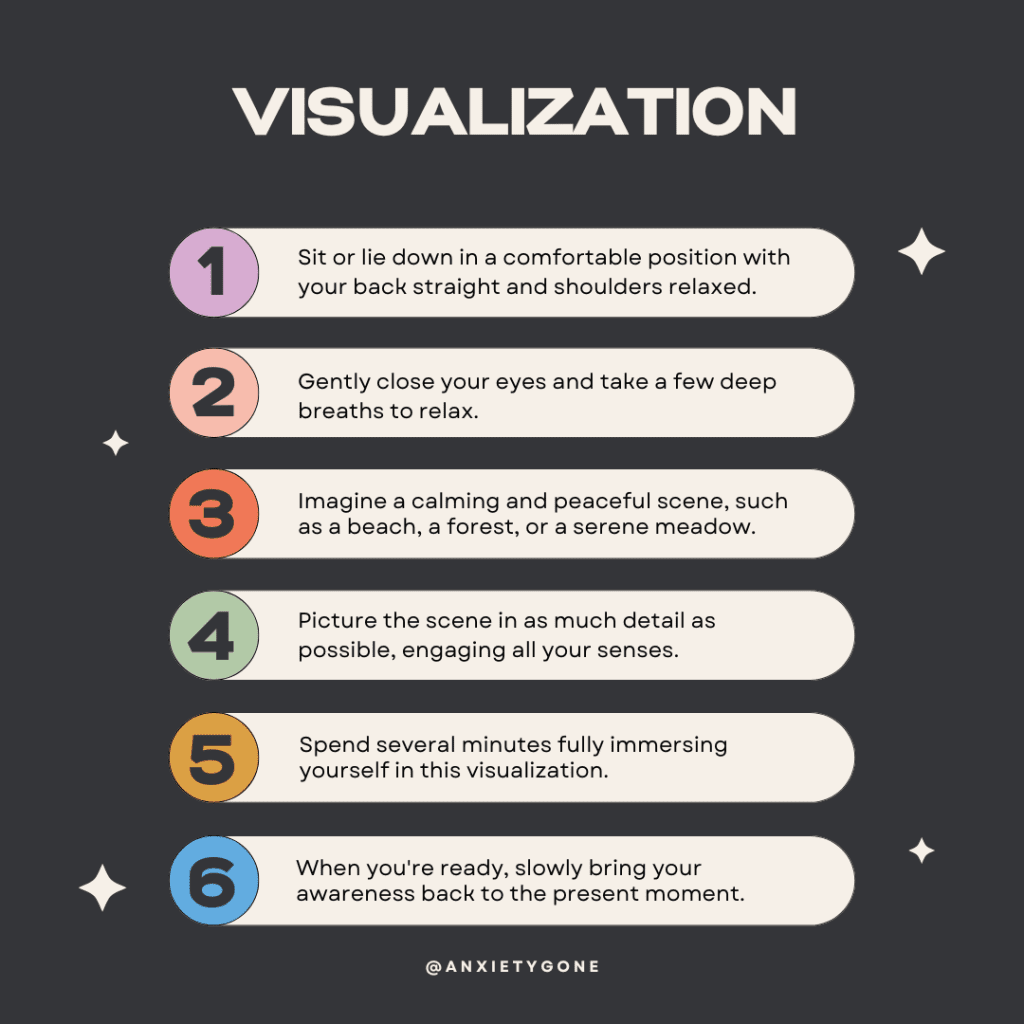 Visualization is a powerful strategy for anxiety management. By vividly imagining a peaceful and positive scenario, you can redirect your thoughts away from anxiety-inducing concerns, promote relaxation, and create a mental oasis of tranquility to soothe your mind and emotions.
Visualization is a powerful strategy for anxiety management. By vividly imagining a peaceful and positive scenario, you can redirect your thoughts away from anxiety-inducing concerns, promote relaxation, and create a mental oasis of tranquility to soothe your mind and emotions.
The best part? You can use this coping method anytime, anywhere! Just follow these simple steps:
- Find a Quiet Space: Sit or lie down in a comfortable, quiet place where you won’t be disturbed.
- Close Your Eyes and Relax: Close your eyes, take a few deep breaths, and allow your body to relax.
- Choose a Peaceful Scene: Imagine a calming and peaceful scene, such as a beach, a forest, or a serene meadow.
- Engage All Your Senses: Picture the scene in as much detail as possible, engaging all your senses. Notice the colors, sounds, smells, textures, and even tastes.
- Immerse Yourself Fully: Spend several minutes fully immersing yourself in this visualization, experiencing the calm and tranquility of the scene.
- Return Gradually: When you’re ready, slowly bring your awareness back to the present moment. Take a few deep breaths, open your eyes, and gently reorient yourself to your surroundings.
9. Humming or Chanting
Humming and chanting offer a unique approach to anxiety relief. These soothing vocal practices, combined with rhythmic vibrations, can help you find a sense of inner calm and balance. By engaging in humming or chanting, you create a harmonious connection between your body and mind, reducing anxiety and promoting a peaceful state of being.
10. Self Massage
Self-massage is a self-care technique that can be incredibly effective for anxiety management. By gently kneading and releasing tension in various parts of your body, self-massage not only helps alleviate physical discomfort but also fosters a deeper connection with your body and a sense of relaxation. This practice promotes a soothing release of muscle tension and can serve as a valuable tool in your anxiety relief toolkit. You can also use acupressure tools to get deeper into the pressure points for maximum relief.
- Find a Comfortable Position: Sit or lie down in a comfortable position where you can easily reach the areas you want to massage.
- Relax and Breathe: Take a few deep breaths to relax your body and mind.
- Choose an Area to Massage: Decide which area of your body needs attention, such as your neck, shoulders, hands, or feet.
- Apply Gentle Pressure: Using your hands, apply gentle but firm pressure to the chosen area. Use your fingers, palms, or knuckles to knead and massage the muscles.
- Use Circular Motions: Rub the muscles in circular motions, slowly increasing the pressure as needed. Pay attention to any areas of tension or soreness and spend extra time on those spots.
- Repeat and Switch Areas: Continue massaging the area for a few minutes, then move to another area if needed. Take your time and repeat the process to enhance relaxation and relieve tension.
11. Autogenic Training
Autogenic training is a relaxation technique with a profound impact on anxiety reduction. By repeating specific phrases that focus on sensations of warmth and heaviness in different parts of your body, you can induce a deep state of relaxation. This method allows you to tap into your body’s natural ability to calm itself, promoting a sense of inner peace and reducing anxiety by building a mind-body connection.
- Find a Quiet Place: Sit or lie down in a comfortable, quiet place where you won’t be disturbed.
- Relax and Breathe Deeply: Close your eyes and take a few deep breaths to relax your body and mind.
- Focus on Heaviness: Mentally repeat to yourself, “My arms and legs are heavy and warm.” Focus on the sensation of heaviness and warmth in your limbs.
- Focus on Warmth: Say to yourself, “My heartbeat is calm and regular.” Concentrate on feeling the warmth spreading through your body and the steady rhythm of your heartbeat.
- Focus on Calm Breathing: Tell yourself, “My breathing is calm and regular.” Pay attention to your slow, steady breaths and the sense of calm they bring.
- Visualize a Peaceful Scene: Imagine a peaceful, relaxing scene, such as a beach or a meadow. Spend several minutes immersing yourself in this visualization, experiencing the calm and tranquility.
12. Tapping (Emotional Freedom Techniques or EFT):
Emotional Freedom Techniques (EFT) tapping is a unique and effective approach to managing anxiety. By tapping on specific acupressure points while acknowledging and verbalizing your emotional distress, EFT can help release emotional blockages and reduce anxiety. This practice combines physical stimulation with emotional expression, allowing you to process and alleviate anxiety-related feelings, ultimately promoting emotional balance and a sense of relief.

